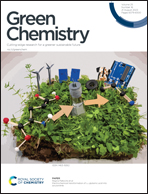Environmental profile of the production of fragrance ingredients used in cosmetic products: comparative analysis of results obtained by life cycle assessment and the green chemistry-based eco-design tool GREEN MOTION™†
Abstract
In the last few decades, sustainability has become one of the main challenges of beauty companies driven by growing consumer demand for more natural-based cosmetics. Fragrances playing a major role in cosmetic formula, they have to be taken into account in the eco-design process of cosmetics. The composition of fragrances can imply up to one hundred different fragrance ingredients, but is most of the time kept secret to protect the professional knowledge of fragance's suppliers. Different eco-design tools exist, based for example on green chemistry principles and metrics. These tools may address various environmental impacts or life-cycle steps, from the single E-factor indicator, which focuses on the amount of waste per amount of product at the production step, to an elaborated set of indicators, like in the GREEN MOTION™ tool developed by MANE. On the other hand, to assess the holistic environmental impacts of products over their whole life-cycle, Life Cycle Analysis (LCA) is the most recognized method. However, it requires extensive amounts of data which can be difficult to obtain or inaccessible for various reasons, including confidentiality. To compare these different possible approaches of fragances eco-design, the results of an LCA of 27 selected fragrance ingredients are compared to those obtained with the green chemistry tool GREEN MOTION™. Fragrance ingredients were found to have a wide range of environmental impacts, depending on their production process and on the starting raw material used. Overall, tendencies observed on results with the 2 tools are in good accordance. This study therefore showcases the complementarity of simplified eco-design tools and metrics with LCA to address environmental impacts of fragrance ingredients. Indeed, the former can be used as a first approach to identify environmental hotspots and implement eco-design practices in the development process of fragrance ingredients, while the latter highlights potential direct and indirect impacts over the upstream life cycle and the ingredient production itself, and can be used to measure the reduction of the global environmental footprint achieved through the implementation of eco-design practices. Based on these results on fragrance ingredients, a clustering method could be developed to help conduct LCA of fragrances.

- This article is part of the themed collections: Chemical waste and pollution and Measuring Green Chemistry: Methods, Models, and Metrics


 Please wait while we load your content...
Please wait while we load your content...